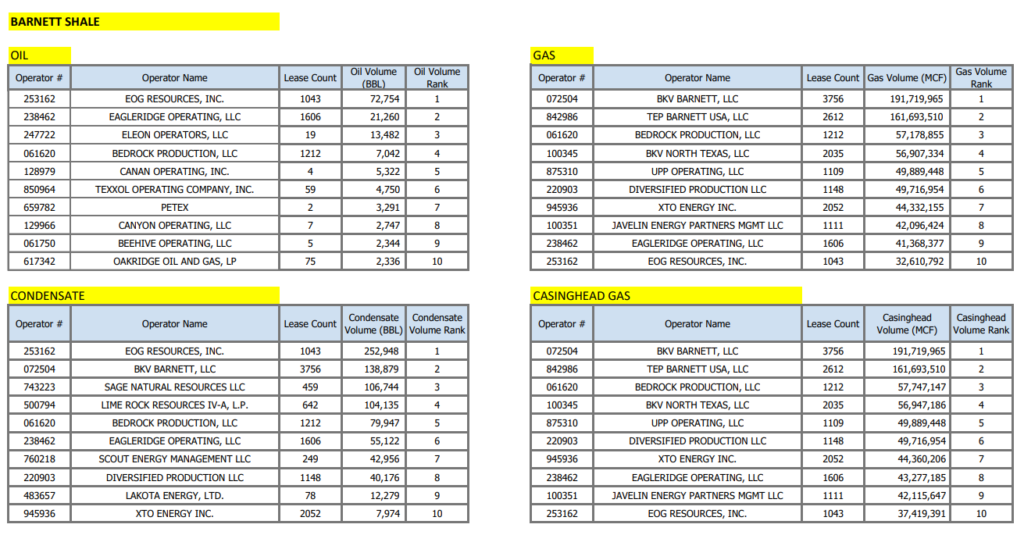In this episode, we provide a summary of the oil and gas activity and historical significance of the Barnett Shale Formation in Texas. The Barnett Shale is one of the most productive shale gas plays in the United States and has played a significant role in the growth of the U.S. energy sector. We cover the geology of the Barnett Shale, the top oil and gas operators, political and economic risks to future development, and what the future may hold for this legacy tight gas play.
This is the ninth episode in our series about the major producing oil and gas basins and plays in the US. Please let us know if you have any requests on a particular area that you would like us to cover. We covered the Permian Basin, DJ Basin, Uinta Basin, Powder River Basin, SCOOP/STACK/MERGE Plays , Haynesville Shale, Williston Basin/Bakken Shale, and Hugoton Gas Field in previous episodes.
Be sure to also subscribe on Apple Podcasts via the link above (or wherever you get your podcasts) and please leave us an honest rating and review. We read every one of them and sincerely appreciate any feedback you have. Let us know if you have an area that you would like us to feature in a future episode; just send an email to feedback@mineralrightspodcast.com.
Let’s dive in to our overview of the Barnett Shale.
Background
The Barnett Shale is an unconventional “tight” gas reservoir, which means that the gas is not easily extracted. The shale is extremely impermeable, making it nearly impossible to extract commercial quantities of gas until oil and gas companies learned to use hydraulic fracturing on a massive scale. By using horizontal drilling, the economics of extracting gas from underdeveloped areas have been improved.
Hydraulic fracturing, also known as “fracking,” is a process of drilling into the earth and injecting a mixture of water, sand, and chemicals into the rock formation to create small fractures. This method allows gas to escape from the rocks and flow into the wellbore, where it can be extracted.
Horizontal drilling has also improved the economics of gas extraction from the Barnett Shale. By drilling down to the shale formation, and then turning the drill bit to drill horizontally within the shale, operators can access more of the shale, which increases the amount of gas that can be extracted.
The Barnett Shale is located in the Fort Worth Basin in Texas, and is estimated to contain significant amounts of natural gas. The shale has been a major contributor to the United States’ natural gas production, and it has also had a significant impact on the local economy, providing jobs and revenue to the region.
Location of the Barnett Shale
The Barnett Shale is a geological formation located in the Bend Arch-Fort Worth Basin in North-Central Texas. It consists of sedimentary rocks dating from the Mississippian period (354–323 million years ago). The formation underlies the city of Fort Worth and underlies 5,000 mi² (13,000 km²) and at least 17 counties.
“According to the Railroad Commission of Texas, the currently defined boundaries of the Barnett Shale formation fall within a 25-county region in north Texas. The Railroad Commission (TRRC) identifies four core counties in Barnett: Denton, Johnson, Tarrant, and Wise. Each of these counties produced over 350 million cubic feet of dry natural gas per day in fourth quarter 2021, and together they accounted for more than 80 percent of the region’s output. Parker and Hood counties also produced a substantial amount of natural gas. “
Geology
The Barnett Shale was named after John W. Barnett, who settled in San Saba County during the late 19th century, where he named a local stream the Barnett Stream. In the early 20th century during a geological mapping expedition, scientists noted a thick black organic-rich shale in an outcrop close to the stream. The shale was consequently named the Barnett Shale.
The formation is located at a depth of 6,000 to 8,000 feet and is made up of black, organic-rich shale. The average total organic carbon (TOC) content in the Barnett Shale is about 4%, and TOC is as high as 12% in samples from outcrops along the Llano uplift on the south flank of the Fort Worth Basin. The Barnett Shale has geochemical characteristics similar to other Devonian-Mississippian black shales found elsewhere in the US.
Reservoir rocks include clastic and carbonate rocks ranging in age from Ordovician to Early Permian. Most production from conventional reservoirs is from Pennsylvanian rocks, whereas the only recognized production from unconventional accumulations is from Mississippian fractured Barnett Shale and early Pennsylvanian (Morrowan) fractured Marble Falls Limestone.
Oil and Gas Production in the Barnett Shale
The field was discovered in 1981 when Mitchell Energy drilled and completed the C. W. Slay #1 near Newark, Texas, in Wise County. That was a vertical well and was completed using a nitrogen foam frac, and was not a huge gas producer at first. That said, the well is still in production today and has produced around 2.1 BCF of gas after being re-completed a couple of times over the years.
George P. Mitchell, the owner of Mitchell Energy, eventually figured out how to economically produce natural gas from the Barnett Shale, after years of experimentation in different completions techniques. Despite low production rates and profitability, Mitchell kept trying different things until he found methods that worked better, like using gel fracs instead of foam fracs. In 1991, Mitchell Energy drilled the first horizontal well in the Barnett but that well was not considered a success. It wasn’t until 1998 when Mitchell was able to figure out the drilling side of things but these wells were still considered economic failures.
An engineer named Nick Steinsberger is credited with coming up with the successful completion design of using a slickwater frac which is commonly used in many unconventional formations today. By doing this, he was able to increase gas recovery and reduce the cost of completing wells. Mitchell tried to buy more leases in the area before other companies caught on, but eventually, lots of other companies started drilling in the Barnett Shale. Despite the competition, Mitchell Energy drilled almost havlf of the Barnett Shale wells in 2001 at 258 vs. all other operators combined drilling 260 wells that year. Mitchell Energy was eventually sold to Devon in 2002.
At the end of the day, Mitchell is credited as the first to successfully combine horizontal drilling and hydraulic fracturing to economically produce hydrocarbons from an unconventional reservoir like the Barnett Shale. This was really the start of the shale revolution and these techniques pioneered by Mitchell are still used today to drill and complete almost all of the horizontal wells that are drilled today.
Gas wells producing from the Barnett Shale of the Fort Worth basin are designated as the Newark, East Gas Field by the Texas Railroad Commission. From 2002 to 2010 the Barnett was the most productive source of shale gas in the US.
While the Barnett kicked off the shale revolution, it is not done yet. In fact, the EIA estimated in 2021 that the proved reserves of the Barnett Shale in the Fort Worth Basin was around 13.6 TCF. With annual production just under 1 TCF per year from the Barnett. With the natural decline from these wells, it is likely that the Barnett will still play an important role in US natural gas production for years to come.
At the end of March of 2023 there was 1 rig operating in the Barnett so there is not a ton of activity but still some new wells getting drilled.

Political Risk
The formation is located in Texas, which is generally favorable to oil and gas development. However, it is also located near the Dallas-Fort Worth metro area, which can create conflicts between residents and the companies operating there. There are concerns about noise and emissions, which can be challenging when drilling in a densely populated area.
The fact that there is a major metropolitan area over the top of the formation means that there is no open land to build a well pad to access some of these reserves. Some of these reserves may never be developed because it is not practical or feasible to do so. However, the development of extremely long laterals could potentially access some of these reserves that were previously inaccessible.
Economic Risk
Another risk is economic risk. Price volatility is always a concern in the oil and gas industry, and there is also competition from other energy sources. As countries try to transition away from fossil fuels, it is important to incorporate other sources of energy, such as renewables and nuclear, in a way that is mindful of energy reliability and availability, and the costs associated with transitioning away from oil and gas. This is not unique to the Barnett Shale, however, and we will rely on fossil fuels for affordable and reliable energy for the foreseeable future.
Outlook
The Barnett Shale has been a significant part of the recent history of the oil and gas industry in the United States. It was one of the pioneers of the shale revolution and allowed the United States to become a major player in the energy market. While it is now on the decline compared to larger shale formations like the Haynesville and Marcellus, it is still producing over one trillion cubic feet of gas a year, making it an important source of natural gas in the country.
Interestingly, some wells drilled in the early 2000s are still producing, and it will be interesting to see how long they continue to do so. If these wells continue to produce for 30-40 years, it will be a testament to the effectiveness of advanced drilling techniques such as hydraulic fracturing and horizontal drilling.
There is always the possibility of discovering deeper formations or new areas for production. For example, in South Texas, drilling Austin Chalk wells has caused a resurgence in certain parts of the Eagle Ford play.
Overall, the Barnett Shale has been an important part of the US energy industry, and its legacy will continue to shape the industry’s future. It will be interesting to see how the industry evolves and how the Barnett Shale fits into the larger picture.
Resources Mentioned in this Episode
- Barnett Shale (Texas Railroad Commission Information & Statistics)
- Bend Arch–Fort Worth Basin – Wikipedia
- Barnett Shale – Dallasfed.org
- ‘Boom!’ As gas drilling expands in Tarrant County, east Fort Worth residents say they’re paying the price
- MRP 131: A Brief History of Oil and Gas Innovation
Thanks for Listening!
To share your thoughts:
- Leave a comment or question below (we read each one and your question may be featured in a future episode)!
- Ask a question or leave us feedback via email or voicemail: (720) 580-2088.
To help out the show:
- Subscribe and leave a review on Apple Podcasts or wherever you get your podcasts – we read each one and greatly appreciate it. Plus, you can get a shout out on a future episode!
Thanks again – until next time!



